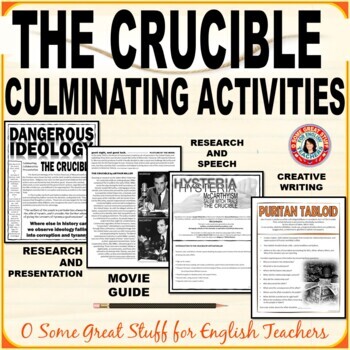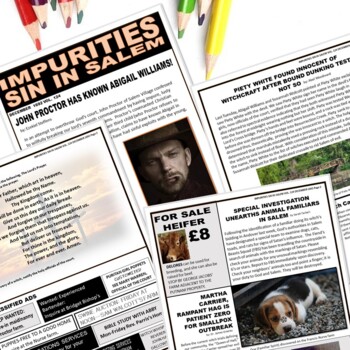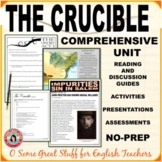The Crucible FIVE Culminating Activities with Independent and Group Projects
- Zip
- Easel Activity
Products in this Bundle (7)
showing 1-5 of 7 products
Also included in
- This complete, no-prep comprehensive unit for Arthur Miller's play, The Crucible includes reading and discussion guides, formal and creative assessments, activities, and presentations to engage your high school ELA students as they study American literature, modern drama, investigate history includPrice $60.00Original Price $74.75Save $14.75
Description
Are you looking for effective and engaging ways to assess your high school ELA students' understanding of The Crucible? Give students choices with these FIVE differentiated culminating activities: researched speech, collaborative research presentation, creative writing Puritan tabloid, movie guide for Good night and Good Luck, and a one-pager activity.
Printable PDF or TPT Digital Easel Activity
✺PROJECT #1 DANGEROUS IDEOLOGY THROUGHOUT HISTORY--
GROUP RESEARCH AND PRESENTATION PROJECT
- Students really enjoy this culminating activity at the completion of Arthur Miller’s play, The Crucible.
- The project is a great way for kids to apply their understanding of the literature to real-world events.
- This activity focuses on the rigid ideology of the Puritans as portrayed in The Crucible and by the accusers during the McCarthy trials.
- There is a brief discussion of the theme, “dangerous ideology."
- There is a subsequent discussion of other times in history where we can observe ideology falling into corruption and tyranny.
- The group project requires students to research people or events in history that illustrate rigid ideology becoming corrupt and tyrannical.
- There is a list of 20 topics from which to choose, for example:
1. Eugene Debs-WWI/Socialism/unions
2. Imperialism vs. Anti-Imperialism-Spanish/American War, 1898
3. Temperance Movement (18th Amendment)
4. Suffragists (19th Amendment)
5. Russian Revolution
Quite a diverse list for a diversity of students’ interests!
- I provide a detailed scoring rubric.
- There are also graphics and quotes about tyranny that relate to the historical topics, The Crucible and McCarthyism.
- This is a wonderful activity for all levels of students.
- encourage students to present their information in creative ways.
- Most create a slide presentation; however, I recently had a group present Eugenics with a game that “kicked people out of the gene pool.”
- In the past students have shown clips from the Manson trials to illustrate the dangers of cults and played clips from Across the Universe to portray the hippy counter-culture.
- Students have videotaped their own portrayals of protests, conducted interviews with historical figures, and decorated the classroom with WW2 propaganda posters.
✺#2 GOOD NIGHT, AND GOOD LUCK-- MOVIE GUIDE
- The movie, Good Night, and Good Luck, details Edward R. Murrow’s pursuit of justice for those falsely accused, unfairly prosecuted, and sadly convicted of crimes for which they were innocent.
- This movie guide prompts students to identify the parallels between the two historical events proving Miller’s play to be an accurate analogy.
- The first page of this resource provides a summary of the plotline of the movie and a review of Arthur Miller’s motivation for writing The Crucible.
- The second page is a list of parallels between McCarthy’s Trials and The Crucible.
- Page 3 provides photos of the actors in their roles, their names, and identification of their position. Also on this page are four poignant quotes by Edward R. Murrow, some spoken in the movie.
- On the next two pages are twenty questions for kids to answer during or after watching the film. There is space provided for their responses.
- Finally, the last three pages provide the key to the students’ questions and additional notes for clarification.
- I use a clear font and provide several relevant graphics.
- My students respond well to this activity.
- The award-winning movie is engaging and sustains their attention.
- They clearly see the analogy between the McCarthy hearings and the witch trials and appreciate the artistry of Arthur Miller.
✺#3 INDUCED HYSTERIA—
RESEARCHED FORMAL SPEECH
- This researched formal speech activity requires students to research The Second Red Scare and McCarthyism, take notes, outline, cite sources, and prepare and deliver a formal speech.
- --I use this as an introduction to our studying Arthur Miller's The Crucible in Honors English class.
- The activity includes fundamental information about McCarthyism and a brief discussion of how Miller created The Crucible, a play about Salem's witch trials as an allegory for America in the early 1950s.
- Although I use this activity to introduce the play, it would also be very effective in the history classroom and could be followed with the movie The Crucible to show the similarities--false accusations and unjust punishment.
- Included are 25 possible research topics from which students can choose.
Examples:
- The Cold War,
- Edward R Murrow,
- The Rosenbergs,
- J. Edgar Hoover.
Included is information on reading, researching, and citing information.
A speech outline template is provided.
There is a general discussion on speech delivery: voice, eye contact, gestures, etc.
A grading rubric is provided.
Clear font.
A few appropriate graphics.
I would recommend this activity for a College Prep or Honors course.
✺#4 THE IMPURE-ITAN—
A CREATIVE WRITING “TABLOID” ACTIVITY
- This is a project that I assign after reading and discussing Act 3 of The Crucible; however, it can be used at any point after that.
- The project begins with a brief discussion of how scandalous Proctor and Abby's affair would be to the citizens of Salem in 1692.
- Following that is a discussion of how people in our society are intrigued by scandal and are drawn to tabloids that reveal the mishaps and misfortunes of celebrities.
- I've included an excerpt that discusses tabloid circulation numbers and the transition from print media to TV and the Internet as a source of rumor collection.
- Students are assigned the task of creating a Puritan tabloid.
- They must include titles, headlines, and bylines.
- They must discuss the events of Salem using Who, What, Where, Why, When, and How. (I provide a chart to help them organize their information.)
- They must also include their speculation about the fall-out from the revelation of John and Abby's affair.
- Students are asked to include three minor articles after reviewing the play through Act three including dramatic exposition and dialogue to determine topics (land-lust, working on the Sabbath, etc.)
- Students are required to include graphics.
- There are remarks about recognizing one's audience where students are told to maintain decorum suitable to Puritan sensibilities; maintain a tone in both words and graphics that is appropriate for a school assignment.
- Students may submit page(s) or a poster
- I include a sample front page.
- This assignment includes a grading rubric and graphics.
- Clear font.
- This project could be used as a group project as well.
- This is always successful in my classes.
BONUS: I've included a one-pager activity where students fill in a template describing characters with quotes and graphics, theme, and other literary elements. Kids love this activity, and it's fun to grade!
A buyer commented, "Great materials to follow up The Crucible unit. I thought that they enhanced my students understanding even more! Thanks!"
Thank you for your consideration of this resource.
Related Product:
Colonial America and Puritanism PowerPoint with Student Worksheet
Explore individual resources for The Crucible; click below:
____________________________________________
Thanks for visiting my store,
Remember to leave feedback for purchases to receive credits toward future resources.
To follow my store and receive notifications
about new resources and store sales, click below:
FOLLOW O SOME GREAT STUFF FOR ENGLISH TEACHERS
Follow me anywhere and everywhere…
Subscribe to my monthly newsletter AND receive a valuable
free resource; click below:
Have a pleasant day! Lori O






